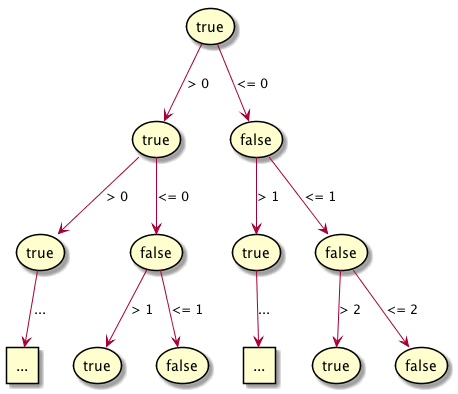This Week I solved an interesting algorithm problem, Jump Game Problem, with State Machine.
The problem is here:
Given an array of non-negative integers, you are initially positioned at the first index of the array.
Each element in the array represents your maximum jump length at that position.
Determine if you are able to reach the last index.
For example: A =
[2,3,1,1,4], returntrue.A =
[3,2,1,0,4], returnfalse.
I’ve seen some solutions also come with an O(n) and constant space performance, but the solution is not easy to understood, and hard to reuse to other problem, but State Machine is a really strong and flexible way to solve limited state (like true/false state) problem.
For this problem, we know that the target is find a way to jump to last index, so we can have a instinct that this problem can be solve by inverse iteration. So let’s have a try in this way.
First, the last index can be skip, as it already the last index, so the state always true no mater what.
Then we come to the 2nd number, we need to jump to last index, that’s next index for this case, so this number should be 1 or above to jump to next. So if this number is > 0, state keep to true, or = 0, state transit to false.
For 3rd number, if 2nd number state is true, we only need to jump to next index. But if 2nd number state is false, we need to jump across 2nd, so this number needs to be > 1 to jump direct to the end.
And we can take more round to iterate all numbers.
Here is a diagram shows the state transition when iterating:

In this diagram, we can find the simple pattern of state transition:
- When current state is true, next state can be true if > 0, else transit to false.
- When current state is false, next state transit to true only if the number is larger than count of continuous falses, else, state keep in false.
So we can write code now:
public boolean canJump(int[] nums) {
boolean stateCanJump = true;
int falseCount = 0;
for (int i = 1; i < nums.length; i++) {
int pos = nums.length - i - 1;
int value = nums[pos];
if (stateCanJump) {
if (value == 0) {
stateCanJump = false;
falseCount = 1;
}
} else {
if (value > falseCount) {
stateCanJump = true;
falseCount = 0;
} else {
falseCount++;
}
}
}
return stateCanJump;
}
And problem solved! Congratulations!
Comments